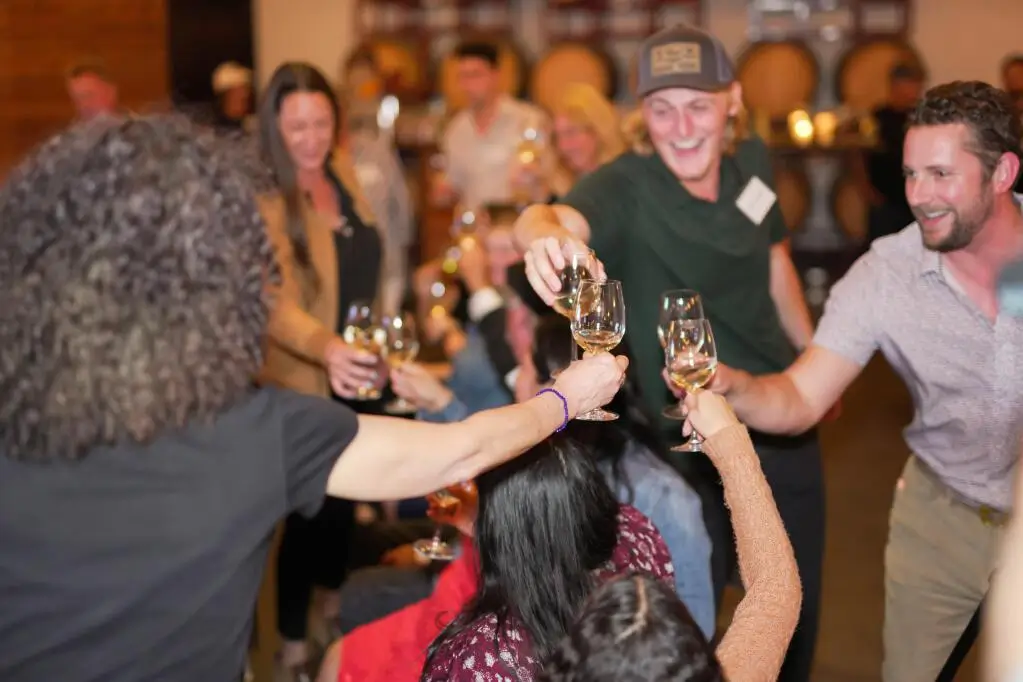What happens now that most Vintage Wine Estates assets have sold


Santa Rosa-anchored Vintage filed for Chapter 11 reorganization on July 24, with $400 million in debts and $425 million in assets. The bankruptcy court in Delaware approved eight sales of assets totaling $140.6 million. Deutsch Family Wines & Spirits’ bid of $16 million for the Ray’s Station winery in Hopland is still pending consideration in court.
Jay Adair, owner of Adair Winery and executive chairman of the Copart vehicle salvage empire, has ambitious plans to breathe new life into the five wineries purchased in mid-October for $85 million: Kunde Estate, B.R. Cohn, Clos Pegase, Girard, and Viansa Sonoma.
Adair, who has been in the wine industry since the late 1990s, plans to invest upwards of $25 million to upgrade the facilities and create a more cohesive, experiential brand across the portfolio.
“We’re going to make them younger, hipper and more exciting,” Adair said. “These brands have been a bit stodgy and neglected, and we’re going to change that.”
Adair’s vision includes bringing a consistent food and hospitality program to all the tasting rooms, as well as upgrading the packaging and winemaking across the brands. He plans to unify the wine club programs, creating a more exclusive, experience-driven membership model.
“It’s not about getting wine at a discount,” Adair said. “We want our wine club members to be ambassadors for the brands, getting access to special events and activities that create a real connection to the wineries.”
Adair’s newly acquired wineries are currently producing around 100,000 cases annually. His goal is to eventually grow that back to 400,000 cases, but he acknowledged that the wine club would likely only make up around 10% of that total volume.
Adair is more interested in creating a sense of quality, scarcity, and exclusivity around the wine club experience than simply driving high-volume direct-to-consumer sales.
“I want people to come out and just have a phenomenal time enjoying the properties, and then that goes to another level when they become a member,” he said.
Along those lines, he’s looking to bring back the music festivals for which B.R. Cohn was known.
In addition to the five Vintage Wine Estates properties, Adair also has plans for his own Adair Winery in Suisun Valley, a lesser-known appellation in western Solano County and also part of the North Coast winegrowing region. There, he is investing heavily in a 12,000-square-foot winery and hospitality complex, inspired by the work in Suisun Valley by Caymus owner Chuck Wagner.
“Suisun Valley reminds me of Napa in the 1970s,” Adair said. “It’s a close-knit community, and we want to create a space that celebrates the region’s agricultural heritage, with gardens, olive trees, and educational experiences for visitors.”
The Adair Winery project, which is slated to open next year, will feature a wine tasting room, as well as event spaces and a pavilion for concerts and festivals. Adair has enlisted renowned winemaker Thomas Rivers Brown to craft the wines.
“This is a long-term investment for me,” Adair said. “I’m not looking to flip these properties or extract value. I want to create something sustainable and enjoyable for generations to come.”
‘If Chicken wine is a trend, dogs might be better’
Foley Family Wines & Spirits acquired five new wine brands totaling approximately 150,000 cases for $15 million: Bar Dog Wine, Cherry Pie Wines, Cosentino Winery, Swanson Vineyards, and Sonoma Coast Vineyards.
The deal included Sonoma Coast Vineyards’ Bodega Bay tasting room.
“It’s a beautiful and unique location with more than 11,000 visitors annually, and 1,400 wine club members,” said Shawn Schiffer, president.
With Cosentino and Swanson are coming 2,000 additional club members, and shipments began last month.
What interested the Foley company with Cosentino is the line of quality wines from Lodi at an “approachable” price around $15 a bottle. Swanson at about $27 “is a great addition to our Napa portfolio where we have strong luxury brands like Merus, Silverado and Foley Johnson,” Schiffer said.
The largest wholesale brands are Cherry Pie, popular California Pinot Noir wines in the ($25-$30), and Bar Dog ($12) with a portion of the proceeds donated to the Petfinder Foundation. “If Chicken wine is a trend, dogs might be better,” Schiffer said. “They are the most popular pet in the U.S. — 65 million U.S. households own one — so we’re going to lean into the brand with some humor and tap into that passion.”
Other asset sales
Jeffrey House, founder of Ace Cider in Sebastopol, is back at the helm of the brand after its $7.63 million purchase by Reva Lipton and Gila Lipton Blum, sisters of the Lipton family who own Ohio-based beer distributor R.L. Lipton Distributing Company.
Total Beverage Solutions acquired the brands Layer Cake, Cartlidge & Browne and Tamarack Cellars for $6 million. The South Carolina company said the deal expanded the company’s portfolio of owned or exclusively represented brands to more than 4 million cases annually.
Denver-based Integrated Beverage Group paid $8.15 million for Firesteed Cellars in Oregon and Clayhouse Wines near Paso Robles. CEO Oren Lewin said the company believes in Oregon wines.
“Firesteed strengthens IBG’s presence in the Willamette Valley, complementing IBG’s existing portfolio of Oregon wines, which include Duck Pond Cellars and Rascal Wines,” Lewin said.
Ejnar Knudsen, managing partner of Davis-based AGR Partners, an early Vintage investor, teamed with Jeff Nicholson and Eric Hickey to buy Laetitia Vineyard and Winery in Central Coastal California’s San Luis Obispo County. Knudsen also purchased Owen Roe in Washington’s Yakima County. The total deal price was $9.3 million.
“My father helped shape early Laetitia releases, and I’ve been involved with the winery for more than 30 years. I’m thrilled to build upon this legacy as a Laetitia partner,” said Hickey, Laetitia general manager and winemaker.
Here are the other asset sales completed so far:
- Barstow Ethanol of Florida’s purchase of the Meier’s Wine Cellars production facility in Cincinnati for $6.25 million.
- Full-Glass Licensing’s $3.2 million pickup of Cameron Hughes, Windsor Vineyards and Vinesse brands.
- XXL Wines, based in Napa and owned by Marc Oliveira of Tri-Vin Wines & Spirits in Connecticut, purchased upwards of 2 million gallons of bulk wine for $2 million. XXL Wines is nominated for Innovator of the Year in Wine Enthusiast’s 25th Wine Stars Awards.
“At the start of 2024, XXL Wines was importing zero cases of wine. Now, they are on track to import 1.5 million cases—making them a force on shelves by taking full advantage of the rapidly expanding flavored and fruit wine category and encouraging use of their products as mixers,” the publication wrote.
Big impact on wine acquisition deals
The Vintage bankruptcy not only resulted in the loss of hundreds of jobs for those not rehired by the new owners but also led to the sale of assets at “very low values,” which has negatively impacted the broader winery, vineyard and brand transaction market, according to Robert Nicholson, whose Healdsburg-based International Wine Associates has advised on about $2 billion in deals.
“Whenever this kind of thing happens, it’s not positive for the transaction market,” Nicholson said.
Vintage’s model was acquiring wineries and brands with a legacy but slower growth then lowering costs by centralizing production and distribution clout.
“It is very difficult in the wine business to buy things that are not performing well and then to turn them around and make them successful,” Nicholson said.
But those anticipated cost savings didn’t materialize because Vintage had too many product items and not a strong growth leader to drive the portfolio, according to beverage industry dealmaker Ian Malone of Aspect Consumer Partners.
“Selling wine is hard, and it has only gotten harder with distributor consolidation and other dynamics in the industry,” Malone said.
Vintage’s model also was complicated by the growth strategy it employed to go public in 2021, a reverse merger with a special purpose acquisition company, or SPAC, according to financial analysts. That led to a compressed window for showing results to investors.
And that’s doubly difficult when the industry is also grappling with a decline in wine sales growth. In this environment, Nicholson believes it will be “quite difficult” for transactions in the next 12 to 24 months, but he is confident that high-quality businesses will continue to find buyers at “respectable” valuations.
“We’re going to see acquisitions happen,” Nicholson said.
Malone said he expects to see more winery assets and brands come onto the market to sell, and buyers looking for assets that fit a strategic goal are anticipated to start shopping again after the results emerge on the critical wine sales period of October through December.
Source: https://www.northbaybusinessjournal.com/article/industrynews/vintage-bankruptcy-sales-adair-foley/
